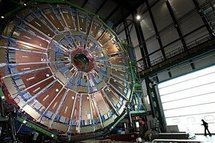
He said the injections lasted a fraction of a second, enough for "a half or even a complete circuit" of the Large Hadron Collider built in a 27-kilometre (17-mile) long tunnel straddling the Franco-Swiss border near Geneva.
CERN's Director General Rolf Heuer said later the scientists had successfully managed to get particle beams once again circulating in the particle accelerator, and that they had been able to go ahead earlier than expected.
"It’s great to see beam circulating in the LHC again... we’ve still got some way to go... but with this milestone we’re well on the way."
The LHC circulated its first beams on September 10, 2008, but suffered a serious malfunction nine days later.
It said a failure in an electrical connection led to serious damage, and that scientists had spent the 14-months since repairing the machine.
The LHC promises to unlock scientific mysteries about the creation of the Universe and the fundamental nature of matter.
Since September 2008, the LHC's components have been tested to an energy equivalent of five teraelectronvolts at full power.
The maximum output of what is currently the largest functioning collider in the world, at the Fermilab near Chicago in the United States, is one teraelectronvolt.
CERN had said in August that upon its relaunch, the LHC would run at 3.5 teraelectronvolts in order to allow its operators to gain experience of running the machine.
The first data should be collected a few weeks after the first particle beam was fired.
CERN said the partial power level would be kept until "a significant data sample has been gathered" and ramped up thereafter.
Designed to shed light on the origins of the universe, the LHC at CERN took nearly 20 years to complete and cost six billion Swiss francs (3.9 billion euros, 4.9 billion dollars) to build.
----------------------------------------------------------------------------------------------------------------------------------
Image: AFP/File/Fabrice Coffrini.
CERN's Director General Rolf Heuer said later the scientists had successfully managed to get particle beams once again circulating in the particle accelerator, and that they had been able to go ahead earlier than expected.
"It’s great to see beam circulating in the LHC again... we’ve still got some way to go... but with this milestone we’re well on the way."
The LHC circulated its first beams on September 10, 2008, but suffered a serious malfunction nine days later.
It said a failure in an electrical connection led to serious damage, and that scientists had spent the 14-months since repairing the machine.
The LHC promises to unlock scientific mysteries about the creation of the Universe and the fundamental nature of matter.
Since September 2008, the LHC's components have been tested to an energy equivalent of five teraelectronvolts at full power.
The maximum output of what is currently the largest functioning collider in the world, at the Fermilab near Chicago in the United States, is one teraelectronvolt.
CERN had said in August that upon its relaunch, the LHC would run at 3.5 teraelectronvolts in order to allow its operators to gain experience of running the machine.
The first data should be collected a few weeks after the first particle beam was fired.
CERN said the partial power level would be kept until "a significant data sample has been gathered" and ramped up thereafter.
Designed to shed light on the origins of the universe, the LHC at CERN took nearly 20 years to complete and cost six billion Swiss francs (3.9 billion euros, 4.9 billion dollars) to build.
----------------------------------------------------------------------------------------------------------------------------------
Image: AFP/File/Fabrice Coffrini.









 Home
Home Politics
Politics









